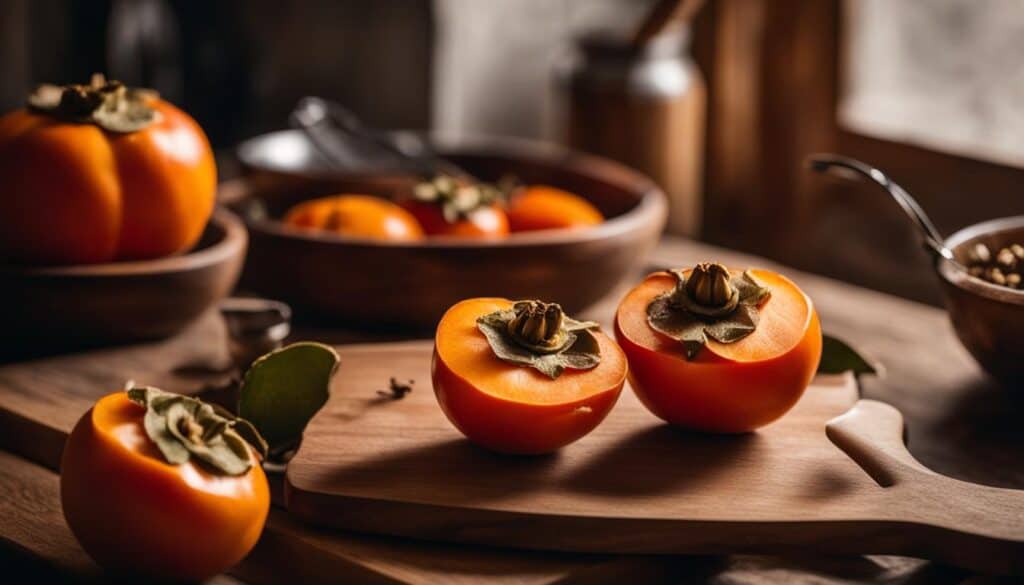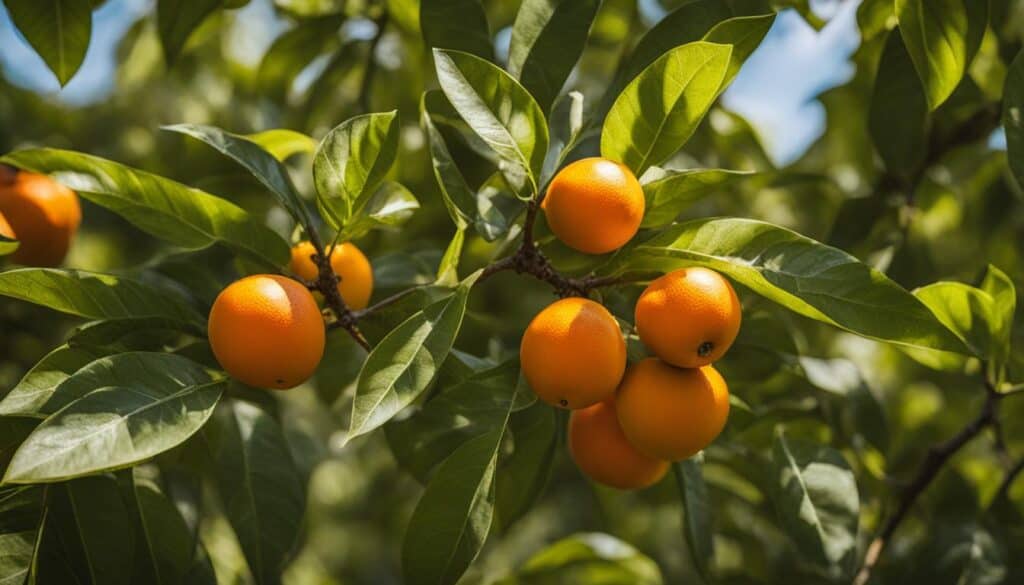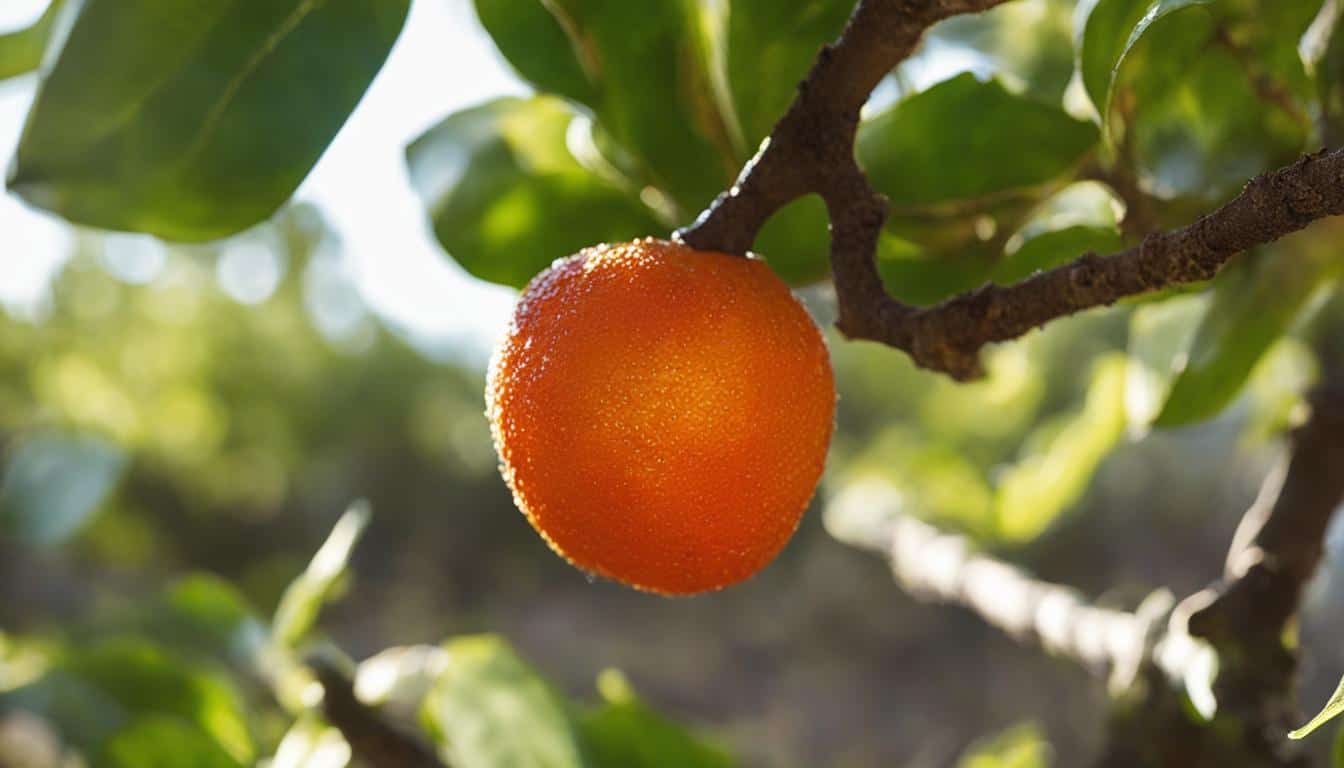Welcome to my blog where we dive into the fascinating world of kaki fruit, also known as persimmon fruit. This popular and versatile fruit is a delicious treat that offers a unique and sweet tangy flavor. Join me as we explore the health benefits, culinary possibilities, and seasonal delight that this exotic fruit brings.
Key Takeaways:
- Kaki fruit, also known as persimmon fruit, is a popular and versatile fruit with a sweet and tangy flavor.
- It offers a range of health benefits and is a delicious treat for any time of the year.
- Explore the various culinary creations you can make with kaki fruit, from salads to jams and baked goods.
- Enjoy the seasonal delight of kaki fruit during its peak season between October and February.
- Support local farmers by choosing kaki fruit grown in the USA and embrace the freshness of locally produced fruit.
The Top 5 Persimmon Varieties for Taste and Texture
When it comes to persimmon varieties, taste and texture play a crucial role in determining the top choices. Some popular persimmon varieties known for their taste and texture include:
| Variety | Taste | Texture |
|---|---|---|
| Firm | Jelly | Gooey |
| Astringent | Non-Astringent | Complex Flavor |
These varieties offer a range of flavor profiles and textures that cater to different palates and preferences. Whether you prefer a firm and crisp persimmon, a jelly-like consistency, or a more gooey texture, there is a persimmon variety that will delight your taste buds.
Some popular choices that consistently stand out among persimmon enthusiasts are the firm varieties that offer a satisfying crunch and a complex flavor. Their astringency adds an element of depth to the taste, making each bite a unique experience. On the other hand, non-astringent persimmons provide a milder and sweeter flavor, with a smoother texture that melts in your mouth.
Astringent vs Non-Astringent Persimmons: A Taste Comparison
Persimmons are a delightful fruit that can be enjoyed in different ways depending on their ripeness. Understanding the difference between astringent and non-astringent persimmons can help you appreciate their unique flavors and textures. While personal preference plays a significant role, let’s delve into the taste comparison of these two types of persimmons.
Astringent Persimmons
Astringent persimmons are typically enjoyed when fully ripe, as their astringency disappears, revealing a luscious and sweet flavor. These traditional astringent persimmons, such as the Hachiya variety, have a thinner skin and a softer, almost jelly-like texture. When you bite into a ripe astringent persimmon, it releases a burst of juicy goodness, leaving a pleasant, wet sensation on your palate.
Non-Astringent Persimmons
On the other hand, non-astringent persimmons can be enjoyed even when they are not fully ripe. They have a firmer texture and a milder, less astringent flavor compared to their astringent counterparts. Non-astringent persimmons, like the Fuyu variety, have a slightly crunchy bite and a sweeter taste. These persimmons are often eaten when they have a firm texture, similar to biting into a crisp apple or pear.
| Type | Ripeness | Texture | Flavor |
|---|---|---|---|
| Astringent Persimmons | Fully ripe | Soft, jelly-like | Rich and sweet |
| Non-Astringent Persimmons | Can be enjoyed when firm | Firm and slightly crunchy | Mild and sweet |
The choice between astringent and non-astringent persimmons ultimately comes down to personal preference. Some people enjoy the intense sweetness and soft, juicy texture of a ripe astringent persimmon, while others prefer the crisp bite and milder flavor of a non-astringent persimmon. Whichever type you choose, persimmons are a delightful fruit that adds a unique touch to your culinary creations.
Best Persimmon Varieties for Fresh Eating
When it comes to enjoying persimmons for fresh eating, there are several favorite varieties that stand out for their exceptional taste and texture. Each variety offers a unique flavor profile that will delight your taste buds. Here are some of the top persimmon varieties that are perfect for enjoying fresh:
| Variety | Description |
|---|---|
| Nishimura Wase | This Japanese variety is small in size and has a sweet and juicy flavor. It is best enjoyed when fully ripe and has a soft texture that melts in your mouth. |
| Saijo | Saijo persimmons are known for their rich and complex flavor. They have a firm texture with a hint of astringency, making them a favorite among persimmon connoisseurs. |
| Miss Kim | This variety is prized for its large size and incredibly sweet taste. Miss Kim persimmons have a jelly-like texture that adds a delightful element to every bite. |
| Nikita’s Gift | Originating from Russia, Nikita’s Gift persimmons have a unique flavor that combines sweetness with a slight tartness. They are juicy and have a firm texture. |
| H63A | This American variety is known for its exceptional sweetness and smooth texture. H63A persimmons are perfect for enjoying fresh or adding to salads and desserts. |
| 20th Century | Also known as Fuyu persimmons, the 20th Century variety is one of the most popular persimmons for fresh eating. They have a crisp texture and a sweet, honey-like flavor. |
| Matsumoto Wase | Matsumoto Wase persimmons are large and have a vibrant orange color. They are juicy, sweet, and have a smooth, creamy texture. |
| Ichi Ki Kei Jiro | This variety is beloved for its sweet and refreshing taste. Ichi Ki Kei Jiro persimmons are small in size with a tender texture that melts in your mouth. |
| Giombo | Giombo persimmons are known for their large size and sweet flavor. They have a smooth and creamy texture that makes them perfect for enjoying fresh. |
| Kyungsun Ban Si | This Korean variety is characterized by its vibrant orange color and sweet flavor. Kyungsun Ban Si persimmons have a firm texture that adds a satisfying crunch. |
| Rojo Brillante | Rojo Brillante persimmons are a popular Spanish variety that is prized for its bright red color and sweet, juicy flesh. They have a smooth and tender texture. |
These are just a few of the many wonderful persimmon varieties available for fresh eating. Each one offers a unique combination of flavors and textures, allowing you to discover your personal favorite. Whether you prefer a sweet and juicy persimmon or one with a firmer texture, there is a variety out there that will satisfy your taste buds.
So why not embark on a persimmon tasting journey and explore the delicious world of fresh persimmons? You’re sure to find a favorite variety that will become a staple in your fruit bowl.
Exploring Different Cooking Options with Persimmons

Persimmons are a versatile fruit that can be used in a variety of delicious culinary creations. From puddings to tarts, there are endless possibilities for incorporating persimmons into your favorite dishes. Whether you’re craving something sweet or savory, these recipes are sure to satisfy your taste buds.
Inspiring Recipes
One of the most popular ways to enjoy persimmons is in puddings. The natural sweetness of the fruit adds a delightful flavor to creamy desserts. Try making a persimmon and cream pudding by blending ripe persimmons with heavy cream, cinnamon, ginger, and nutmeg. Chilled in the refrigerator, this silky smooth pudding is a perfect treat on a warm day.
If you’re more inclined to bake, persimmon tarts are a great choice. The combination of persimmons with apple, pear, or orange creates a delectable filling. Sprinkle the fruit with a mixture of cinnamon, ginger, nutmeg, cardamom, and a touch of black pepper for a warm and spicy twist. Bake the tart in a flaky pie crust, and you’ll have a dessert that’s both visually stunning and incredibly flavorful.
| Recipe | Description |
|---|---|
| Persimmon and Cream Pudding | A silky smooth pudding made with ripe persimmons and heavy cream, flavored with cinnamon, ginger, and nutmeg. |
| Persimmon Tart with Spiced Fruit Filling | A delicious tart filled with a combination of persimmons and spiced apple, pear, or orange, baked in a flaky pie crust. |
“The sweet and tangy flavor of persimmons adds a unique twist to traditional desserts and baked goods.” – Chef Emily
Additionally, persimmons can be used in salads to add a fresh and vibrant touch. Sliced persimmons pair well with greens, such as arugula or spinach, and can be combined with ingredients like goat cheese, candied pecans, and a tangy vinaigrette for a refreshing and satisfying salad. The natural sweetness of the fruit balances perfectly with the savory and tangy elements, creating a harmonious flavor profile.
Whether you’re a fan of puddings, tarts, or salads, persimmons offer a unique and delicious addition to your culinary repertoire. Experiment with different recipes and flavors to discover the endless possibilities of cooking with persimmons.
Exploring the Exotic Appeal of Kaki Fruit
Kaki fruit, also known as persimmon fruit, has an exotic appeal due to its unique flavor and visual appearance. The sweet and tangy taste of kaki fruit sets it apart from other fruits, offering a delightful experience for the taste buds. The vibrant orange color and distinctive shape of the fruit add to its exotic appeal, making it a visually appealing addition to any dish or fruit basket.
When it comes to flavor, kaki fruit offers a combination of sweetness and tanginess that is truly one-of-a-kind. The balance between these two taste profiles creates a harmonious and refreshing sensation on the palate. Whether enjoyed on its own or incorporated into various recipes, kaki fruit brings a unique and exotic twist to any dish.
Not only does kaki fruit have an exceptional flavor, but it also boasts a mesmerizing visual appeal. The vibrant orange hue of the fruit catches the eye and instantly adds a pop of color to any culinary creation. Its distinct shape, reminiscent of a tomato, adds an element of intrigue and excitement to the fruit. Whether used as a centerpiece in a fruit bowl or sliced beautifully in a salad, kaki fruit never fails to captivate with its visual allure.
Next time you’re looking to add an exotic touch to your meals, consider incorporating kaki fruit. Its sweet and tangy flavor, unique visual appeal, and versatility make it a standout ingredient that will elevate any dish to new heights of culinary delight.
Seasonal Delight: Enjoying Kaki Fruit in its Peak Season

One of the joys of indulging in kaki fruit, also known as persimmon fruit, is savoring it during its peak season. From October to February, kaki fruit is at its best in terms of flavor, texture, and availability. It’s the perfect time to experience the full delight of this seasonal fruit.
During this period, kaki fruit showcases its vibrant orange color and distinctive shape, making it a visually appealing addition to any fruit basket or dish. The flavor of kaki fruit reaches its peak, with a perfect balance of sweetness and tanginess that tantalizes the taste buds. The texture is also at its finest, providing a juicy and succulent eating experience.
Whether enjoyed fresh on its own, added to salads, or incorporated into various culinary creations, kaki fruit shines during its peak season. Its versatility allows for endless possibilities in the kitchen, from chutneys and jams to smoothies and baked goods. Embrace the seasonal delight of kaki fruit and explore the wonders it has to offer!
I love enjoying kaki fruit when it’s in season. The burst of flavor and juiciness make it a true delight. Its unique taste adds depth to my salads and brings a refreshing twist to my baked goods. Don’t miss out on this seasonal gem!
Table: Peak Season Availability of Kaki Fruit
| Month | Availability |
|---|---|
| October | Coming into season, limited availability |
| November | Peak availability, abundant supply |
| December | Peak availability, abundant supply |
| January | Peak availability, abundant supply |
| February | Coming towards the end of the season, limited availability |
Enjoy the seasonal delight of kaki fruit by savoring it at its freshest and most flavorful. Whether you’re enjoying it as a healthy snack or incorporating it into your favorite recipes, kaki fruit is sure to delight your taste buds and add a touch of exoticism to your meals. Indulge in the peak season availability of kaki fruit and elevate your culinary experience with this versatile and delicious fruit.
The Health Benefits of Kaki Fruit

Kaki fruit, also known as persimmon fruit, is not only a delicious and versatile fruit but also offers a range of health benefits. Packed with antioxidants, vitamins, minerals, and fiber, kaki fruit is a nutritious addition to any diet.
Antioxidants in kaki fruit help protect the body against free radicals, which can cause cellular damage and contribute to chronic diseases. These antioxidants, including vitamin C and beta-carotene, support a healthy immune system and help reduce the risk of various illnesses.
In addition to antioxidants, kaki fruit is a good source of vitamins A and E, which contribute to healthy skin, vision, and immune function. The fruit also contains minerals such as potassium, manganese, and copper, which are essential for proper nerve function, bone health, and energy production.
Furthermore, the high fiber content in kaki fruit supports healthy digestion, aiding in proper bowel movements and preventing constipation. The fiber also helps regulate blood sugar levels and contributes to a feeling of fullness, making it beneficial for weight management.
The Health Benefits of Kaki Fruit:
- Rich in antioxidants that protect against free radicals
- Good source of vitamins A and E for healthy skin and vision
- Contains minerals for proper nerve function and bone health
- High fiber content supports healthy digestion and weight management
“The antioxidants in kaki fruit help protect the body and support a healthy immune system. With its vitamins, minerals, and fiber, kaki fruit is a powerhouse of nutrition.” – Nutritionist Jane Smith
| Nutrient | Amount per 100g |
|---|---|
| Calories | 81 |
| Protein | 0.6g |
| Total Fat | 0.4g |
| Carbohydrates | 21g |
| Fiber | 3.6g |
| Potassium | 161mg |
| Vitamin C | 66% of the daily value |
So, whether you enjoy kaki fruit fresh, add it to salads, or incorporate it into your favorite recipes, you can reap the many health benefits this delicious fruit has to offer. It’s a true gem of nutrition that can enhance your well-being and add a burst of flavor to your meals.
The Versatility of Kaki Fruit in Culinary Creations

One of the things that makes kaki fruit truly special is its versatility in culinary creations. From savory to sweet, this exotic fruit can be used in a variety of dishes, adding a unique flavor and texture that will delight your taste buds. Whether you’re making salads, smoothies, jams, or baked goods, kaki fruit is sure to elevate your culinary creations to a whole new level.
In salads, kaki fruit adds a burst of sweetness and juiciness. Its delicate flavor pairs well with crisp greens, nuts, and tangy dressings, creating a refreshing and satisfying dish. You can also experiment with different textures by combining the ripe fruit with crunchy vegetables or creamy cheese for a delightful contrast.
When it comes to smoothies, kaki fruit adds a naturally sweet and tangy element. Blend it with your favorite fruits like banana, mango, or berries for a refreshing and nutritious drink. The smooth and creamy texture of kaki fruit makes it a perfect base for creamy smoothies that will keep you energized throughout the day.
If you’re a fan of jams and spreads, kaki fruit can be transformed into a delicious preserve. Its natural pectin content makes it an excellent choice for jams, providing a naturally thick and luscious texture. Combine it with complementary flavors like citrus or spices such as cinnamon, ginger, or cardamom for a unique twist.
Baked goods also benefit from the addition of kaki fruit. Its natural sweetness makes it a great alternative to traditional sweeteners in recipes like cakes, bread, and muffins. The moist texture of kaki fruit keeps baked goods soft and tender, while its flavor adds a delightful complexity that will have you coming back for more.
Exploring Kaki Fruit in the USA

In addition to being a beloved fruit around the world, kaki fruit, also known as persimmon fruit, is successfully grown in the USA. This means that you can enjoy the deliciousness of kaki fruit while supporting local farmers and enjoying locally grown produce. The availability of kaki fruit in the USA may vary depending on the region and the seasonal conditions, but when you find it, it’s a treat worth savoring.
By opting for kaki fruit grown in the USA, you not only get to experience the freshness and quality of local produce, but you also contribute to the local agriculture industry and the farm-to-table movement. Supporting local farmers is an important way to strengthen the economy and promote sustainable practices. So, next time you’re shopping for fruits, keep an eye out for kaki fruit that’s proudly grown in the USA.
Whether you’re indulging in kaki fruit’s sweet and tangy flavor on its own, incorporating it into your favorite recipes, or exploring new culinary creations, kaki fruit grown in the USA guarantees freshness and local goodness. So why not add the exotic appeal of kaki fruit to your shopping list and embark on a flavorful journey right in your own backyard?
Supporting Local Farmers: A Win-Win Situation
When you choose kaki fruit grown in the USA, you not only get to enjoy the unique flavor and versatility of this exotic fruit, but you also contribute to the success and sustainability of local farmers. By purchasing local produce, you support the local economy, reduce the carbon footprint associated with long-distance transportation, and ensure that you’re getting the freshest and most flavorful kaki fruit available. So, it’s a win-win situation – treat yourself to the wonder of kaki fruit while supporting your local community!
| Kaki Fruit Varieties Grown in the USA | Availability |
|---|---|
| Nishimura Wase | October |
| Saijo | November |
| Nikita’s Gift | December |
Conclusion
I have thoroughly enjoyed exploring the wonder of kaki fruit, also known as persimmon fruit, with you. This fascinating fruit offers a plethora of health benefits, from its rich antioxidant content to its abundance of vitamins and minerals. Incorporating kaki fruit into your diet can support cardiovascular health, boost the immune system, and aid in digestion.
Not only does kaki fruit offer impressive health benefits, but its flavor is also truly unique. The sweet and tangy taste of kaki fruit adds a delightful burst of flavor to any dish or snack. Its versatility in culinary creations is equally remarkable, whether used in fresh salads, refreshing smoothies, decadent jams, or scrumptious baked goods.
As a seasonal delight, kaki fruit is at its peak between October and February. During this time, it is readily available and at its freshest, ensuring the best possible flavor and texture. Embracing kaki fruit during its season allows you to fully appreciate its deliciousness and enjoy the benefits of consuming local produce.
So, embrace the wonder of kaki fruit and let it enhance your culinary experiences. Whether you savor it fresh, incorporate it into your favorite recipes, or explore new creations, kaki fruit is a treasure that brings flavor, versatility, and a touch of seasonal delight to your table.
FAQ
What is kaki fruit?
Kaki fruit, also known as persimmon fruit, is a popular and versatile fruit with a sweet and tangy flavor. It is known for its exotic appeal and delicious taste.
What are the top persimmon varieties for taste and texture?
Some popular persimmon varieties known for their taste and texture include Nishimura Wase, Saijo, Miss Kim, Nikita’s Gift, H63A, 20th Century, Matsumoto Wase, Ichi Ki Kei Jiro, Giombo, Kyungsun Ban Si, and Rojo Brillante.
What is the difference between astringent and non-astringent persimmons?
Astringent persimmons are enjoyed when fully ripe, as their astringency disappears and they offer a richer and sweeter flavor. Non-astringent persimmons can be enjoyed even when not fully ripe and have a milder flavor. Astringent persimmons often have thinner skin, full flavor, and a softer, wet, or juicy texture.
What are the best persimmon varieties for fresh eating?
Some favorite persimmon varieties for fresh eating include Nishimura Wase, Saijo, Miss Kim, Nikita’s Gift, H63A, 20th Century, Matsumoto Wase, Ichi Ki Kei Jiro, Giombo, Kyungsun Ban Si, and Rojo Brillante.
How can persimmons be used in cooking?
Persimmons can be used in various culinary creations, such as puddings, tarts, salads, smoothies, jams, and baked goods. They pair well with flavors like apple, pear, orange, cream, cinnamon, ginger, nutmeg, cardamom, and black pepper.
What makes kaki fruit exotic?
Kaki fruit, also known as persimmon fruit, has an exotic appeal due to its unique flavor and visual appearance. Its sweet and tangy taste sets it apart from other fruits, and its vibrant orange color and distinctive shape add to its exotic appeal.
When is kaki fruit in season?
Kaki fruit is at its best from October to February, during its peak season. This is when it is freshest, most flavorful, and widely available.
What are the health benefits of kaki fruit?
Kaki fruit is rich in antioxidants, vitamins, minerals, and fiber, which support overall health. It benefits cardiovascular health, boosts the immune system, and aids digestion.
How can kaki fruit be used in culinary creations?
Kaki fruit is versatile and can be used in various ways, such as in salads, smoothies, jams, baked goods, and more. Its unique flavor and texture add depth to culinary creations.
Is kaki fruit grown in the USA?
Yes, kaki fruit, or persimmon fruit, is also grown in the USA. Depending on the region, it may be locally available, allowing you to support local farmers and enjoy the freshness of locally grown produce.





Leave a Reply